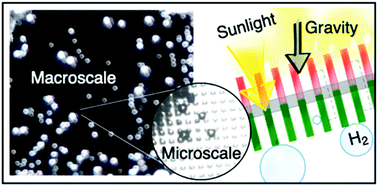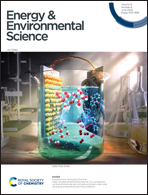Effects of bubbles on the electrochemical behavior of hydrogen-evolving Si microwire arrays oriented against gravity†
Abstract
The size-distribution, coverage, electrochemical impedance, and mass-transport properties of H2 gas-bubble films were measured for both planar and microwire-array platinized n+-Si cathodes performing the hydrogen-evolution reaction in 0.50 M H2SO4(aq). Inverted, planar n+-Si/Ti/Pt cathodes produced large, stationary bubbles which contributed to substantial increases in ohmic potential drops. In contrast, regardless of orientation, microwire array n+-Si/Ti/Pt cathodes exhibited a smaller layer of bubbles on the surface, and the formation of bubbles did not substantially increase the steady-state overpotential for H2(g) production. Experiments using an electroactive tracer species indicated that even when oriented against gravity, bubbles enhanced mass transport at the electrode surface. Microconvection due to growing and coalescing bubbles dominated effects due to macroconvection of gliding bubbles on Si microwire array cathodes. Electrodes that maintained a large number of small bubbles on the surface simultaneously exhibited low concentrations of dissolved hydrogen and small ohmic potential drops, thus exhibiting the lowest steady-state overpotentials. The results indicate that microstructured electrodes can operate acceptably for unassisted solar-driven water splitting in the absence of external convection and can function regardless of the orientation of the electrode with respect to the gravitational force vector.



 Please wait while we load your content...
Please wait while we load your content...